Tierra del Fuego & Patagonia
In the second of this three-part guest blog Karen von Gerlach, our South African friend, continues her Argentine epic to ‘The end of the world’
Wednesday, 28 October 2015
Argentina is enormous – the eighth largest country in the world. It says in a tourist brochure – if Argentina could be stretched out over Europe, with its northwest corner positioned over London, the country’s easternmost point would lie roughly over Budapest. Its southernmost tip, Tierra del Fuego would be roughly over Timbuktu in Mali, about a third of the way down the African continent. So we had to fly in fact eight times during our four-week adventure trying to catch just a glimpse of this truly fascinating country. And this doesn’t include our 36hr flights from Cape Town via Istanbul, Sao Paulo, and Buenos Aires and back again.
Our time in Buenos Aires had come to an end for the time being. Our next stop was Ushuaia, the capital of the Provincia de Tierra del Fuego. We had left Buenos Aires from Aeroparque Internacional Jorge Newbery early in the morning at 2h30 and arrived some three hours later in a truly magnificent snow-covered fairy tale mountain paradise. I had been told before that the flight to Malvina Argentina Airport involves the most spectacular airplane descent in all Argentina.
We were completely in awe, the snow-capped mountain scenery was so incredibly beautiful, however the landing strip was incredibly short, and I said a thank-you prayer that we didn’t overshoot the landing strip with our trip coming to an untimely end in the Beagle Channel.
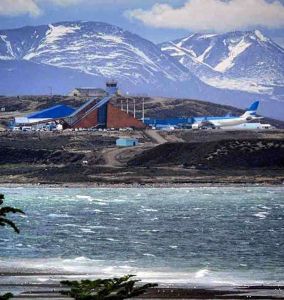 Tierra del Fuego, The Land of Fire, lies at the southern tip of the South American continent. The very name evokes feelings of eeriness, distance, isolation and loneliness. You really feel like you have reached the edge of the world here. In fact, as we were to find out, there are an endless number of places and brands whose names incorporate the phrase Fin del Mundo (End of the world).
Tierra del Fuego, The Land of Fire, lies at the southern tip of the South American continent. The very name evokes feelings of eeriness, distance, isolation and loneliness. You really feel like you have reached the edge of the world here. In fact, as we were to find out, there are an endless number of places and brands whose names incorporate the phrase Fin del Mundo (End of the world).
Our taxi driver was there to meet us and took us to our Hotel, Las Cauquenes, some 4kms outside of the town. What a beautiful hotel; boasting panoramic views of the Beagle Channel and beautiful views of the mountains. Since we had arrived so early, we couldn’t get access to our room, so we had a scrumptious little breakfast, mesmerized by the splendid view and then decided to take a taxi into town to look around and book some tours for the next two days.
The city of Ushuaia sits in a picturesque bowl on the southern side of the mountains, (to the East rise the peaks of the spectacular, pointed Monte Olivia and the Cinco Hermanos (Five Brothers) overlooking Bahia Ushuaia, the Canal Beagle and Navarino and Hostel Islands to the south. Ushuaia is the home of a large naval base, government offices and stores for imported goods. The other growth industry around here is tourism. And you see tourists everywhere, from all corners of the world, which makes Ushuaia particularly interesting. We were tired by now – after all we had to get up early in the morning – but still managed to make our way up the steep hill to the main thoroughfare, Avenida San Martin, with its strange variety of architecture, early wooden houses covered with corrugated iron (to help prevent fires), prisoner-produced gingerbread decorations adding a somewhat Russian flavor; intermingled with modern concrete structures, imported Swedish prefabs and hundreds of small wooden shanties. Ushuaia is so different from everything I have ever seen, it really had an other-worldly feeling for me, somehow haunted and eerie, topped by the overcast skies and cold weather – yes, an “at the end of the world feeling”. It is difficult to describe Ushuaia, but I know I was in awe and will forever treasure these three days as something very special and unique in my life.
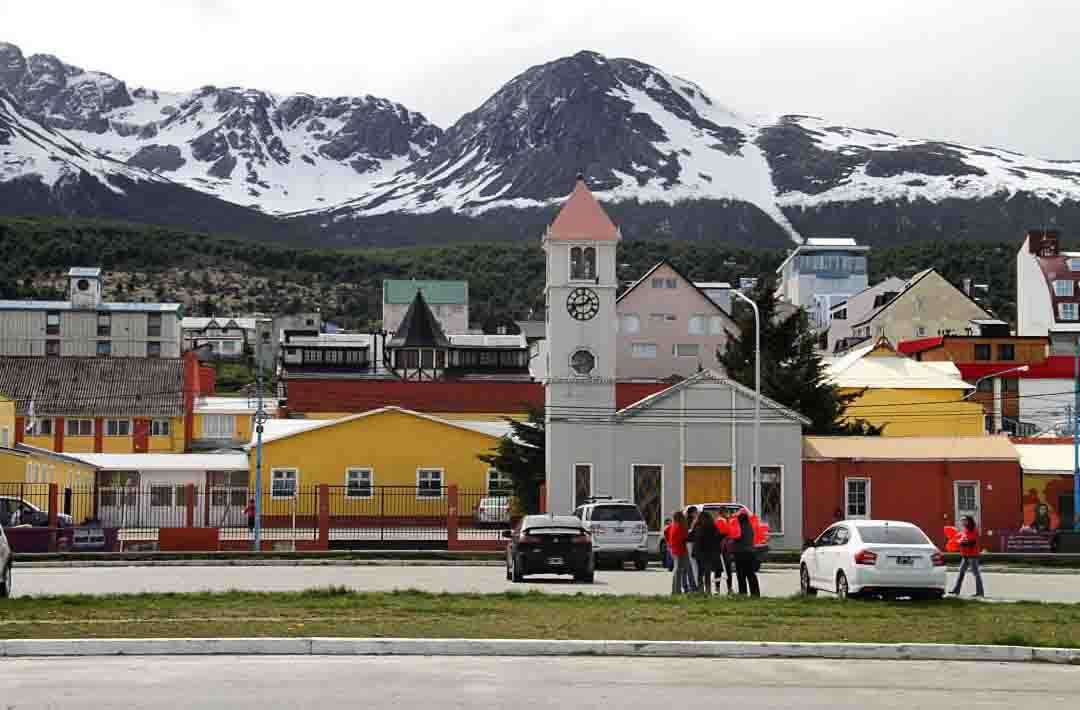
Over the next two days we would hear a lot about Ushuaia’s history. The earliest record is an 11,800 –year old site in northern Tierra del Fuego occupied by nomadic hunters – people who near the end of the Ice Age crossed the Magellanic land bridge before waters broke through it. On the arrival of the Europeans in the early sixteenth century, four cultural groups populated the area; eliminated mainly by “white man’s” diseases, fewer than five pure members remain of the first three groups, we were told. 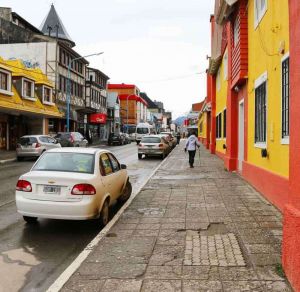
The European exploration of Tierra del Fuego, first by Magellan in 1520, then by pirates, explorers, collectors, scientists, sealers and whalers, and missionaries, gold prospectors and merchants is one of the great adventure stories in history. I still have childhood memories of reading stories of the exploits of Drake, Cook and Darwin.
By 15h00 we had had enough and were yearning for some rest. So back to the hotel and a good sleep, in fact Kai watched Rugby…. And in the evening we ate a superb salmon in the hotel. I know I can make a good salmon, but this one might have been “slightly” better, and it was a huge piece too.
Thursday, 29 October 2015
At 08h00 our bus was waiting for us to take us to the Tren del Fin del Mundo (The End of the World Train – “again” Fin del Mundo”) in the Parque Nacional Tierra del Fuego, a steam-powered tourist train whose original function was to take convicts from Ushuaia’s prison to fell trees in the outlying forests.
This is in fact an interesting bit of history, Argentina’s most dangerous criminals, notorious serial killers and master forgers were held in Ushuaia’s former prison, in the first half of the 20th century; a forbidding facility that is now part of the naval base. We were told a few horrifying stories about the hard life of these prisoners in these unrelenting and cold forests, with no hope of ever escaping.
The steam train took us past glaciers, waterfalls, lakes and beech forests; for us a spectacular wonderland up a mountain where the bus was waiting to take us on a tour through the Park, past more impressive scenery, lakes, mountains and forests. I experienced this world as mind-boggling, wondrous; it is difficult to put into words what I felt. I had the same emotions on many other occasions in Argentina. It is just a most spectacular country.
Friday, 30 October 2015
At 08h00 AGAIN – our bus picked us up for our day tour to the north of Ushuaia. Driving out of town along the RN3 towards Rio Grande provided a crash course in ecology, as we passed through thick forest of evergreen southern beech, deciduous forests of lenga or “high beech”, valleys filled with swamps. It was again bitterly cold, and I was again fascinated by the majestic, snow-covered mountains and scenery. 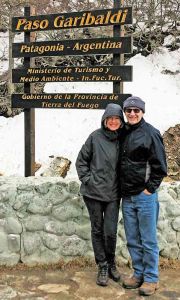 We stopped at the lookout on Paso Garibaldi to look north over Lago Escondido and Lago Fagnano, ice cold and nearly swept away by the relentless and ever present cold wind.
We stopped at the lookout on Paso Garibaldi to look north over Lago Escondido and Lago Fagnano, ice cold and nearly swept away by the relentless and ever present cold wind. 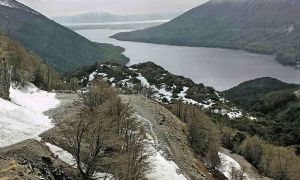 The bus then skirted both lakes and, although by now pretty tired, we joined a group and walked along the rocky landscape for a short distance, past beavers’ dams and small farmsteads, towards the sparkling lake. On our return we had lunch high up on the mountain, some funny food which I cannot remember, but it was by then welcome. In the evening, after one or two or more glasses of wine we had an early night, dreaming of adventurers and stormy seas and convicts and the original island inhabitants’ campfires dotting the landscapes, from which “Tierra del Fuego” supposedly got its name. What an incredible adventure for us too.
The bus then skirted both lakes and, although by now pretty tired, we joined a group and walked along the rocky landscape for a short distance, past beavers’ dams and small farmsteads, towards the sparkling lake. On our return we had lunch high up on the mountain, some funny food which I cannot remember, but it was by then welcome. In the evening, after one or two or more glasses of wine we had an early night, dreaming of adventurers and stormy seas and convicts and the original island inhabitants’ campfires dotting the landscapes, from which “Tierra del Fuego” supposedly got its name. What an incredible adventure for us too.
Saturday, 31 October 2015
And the best part was still to come – for me at least. I think Kai could possibly have done without this. It was snowing when we woke up in the morning. I was overwhelmed, I had never seen it snowing before and what an experience. During breakfast I tried to capture the snowflakes on video, and just relished this new adventure. Not being a very enthusiastic flyer, I was of course concerned how the airplane would be able to take off, but everybody reassured me that this was routine in these parts of the world, and off we went to El Calafate via Buenos Aires.
This is how it works in Argentina. Buenos Aires is the Hub for all its planes, which means we could only reach our next destination via Buenos Aires. And that robbed us of some precious time in this beautiful country, but so be it. So this Saturday we spent on airports, until we arrived in the late afternoon in El Calafate, a city in Patagonia, situated in the southern border of Lake Argentino, in the southwest part of the Santa Cruz Province. El Calafate is the starting point for accessing Argentina’s famous glaciers. And we couldn’t believe our eyes – it seemed like we had arrived in the Karoo; same flat landscape, same vegetation, and a howling wind.

We were fortunate that on our arrival at Hotel Design Suites, with a room facing the lake, an agent phoned us with suggestions for tours, which meant that we would still be able to book a full-day tour for the next day. It also meant, however, that we had to rush back into town before close of business to pay for our tours. We had not pre-booked tours from South Africa, which put us under a bit of pressure once we arrived at a destination, to first find a tour operator, compare some prices and then make a booking; because of course we wanted to see as much as possible during our limited time.
Sunday 1 November 2015
Several of South America’s most spectacular glaciers are contained within the Southern Lake District of Patagonia. The glaciers spill down from the Southern Patagonian Ice Field which straddles the Andes and covers large tracts of Argentina and Chile. As it said in the tourist brochure, ‘for tourists searching for a place surrounded by woods, lakes and impressive glaciers to enjoy rural tourism’, they would have the chance to visit one of the most symbolic venues in the southern region, namely Estancia Cristina. Its privileged location promised the best land access to the Upsala Glacier and the continental ice field, turning this site into a paradise second to none. We chose the Discovery Upsala tour, which consisted of navigating Lago Argentino and its northern arm to the estancia.
This morning we had to wait a little, but our bus did eventually arrive to pick us up. The bus trip took us 45kms through stunning countryside, which looked uncannily familiar, again reminding me of the Karoo, to the port at Punta Bandera, where we got on board a luxurious, but packed catamaran. Before reaching the estancia, where a tourist guide was awaiting us to take us on a tour of the estancia, we sailed around ice floes and imposing scenes.
The icebergs adrift provided a magical sensation to the voyage. One of the most beautiful shows is put up by calving. The wind, the sun and the rain give shape to the glacier, creating various figures chosen by visitors for their photographs. How I wished that I had had a really good camera plus the knowledge how to use it too!
Monday, 2 November 2015
Patagonia is where South America tapers, fragments and then ends at Tierra del Fuego. The Patagonia of the glossy magazines, of primeval forests, crystalline rivers, glaciers as high as apartment buildings and turquoise lakes are however only a fraction of the whole. The rest is desert or steppe, a harsh environment in which only straggly bushes and hardy breeds of sheep can eke out a living. As someone said to me, ‘Imagine a blank canvas in an ornate frame and you will have a good idea of what Patagonia is really like’.
Ferdinand Magellan, Pedro Sarmiento de Gamboa, Francis Drake and Thomas Cavendish are just a few of the many explorers who set foot on this land in the sixteenth century. European law and customs gave way to the most violent passions: revolts, mutinies, banishments and executions were common. The early inhabitants of this land had been there long before the white man arrived and they stood their ground. The bravest were the Mapuches, a nomadic tribe, who lived on both sides of the Andes in the northern part of Patagonia. For 300 years they led a violent lifestyle on the plains by stealing and plundering the larger estancias of the rich pampas. In 1879 the Argentine Army, under General Roca, set out to conquer the land from the Amerindians. The campaign which lasted until 1888 is known as the Conquest of the Desert. It put an end to years of Amerindian dominion in Patagonia and opened up a whole new territory for colonization. The country was slowly occupied by people of very diverse origins, which reminded me of our own colonization here in SA. The Patagonian towns grew fast, transforming it into a modern industrial frontier land.
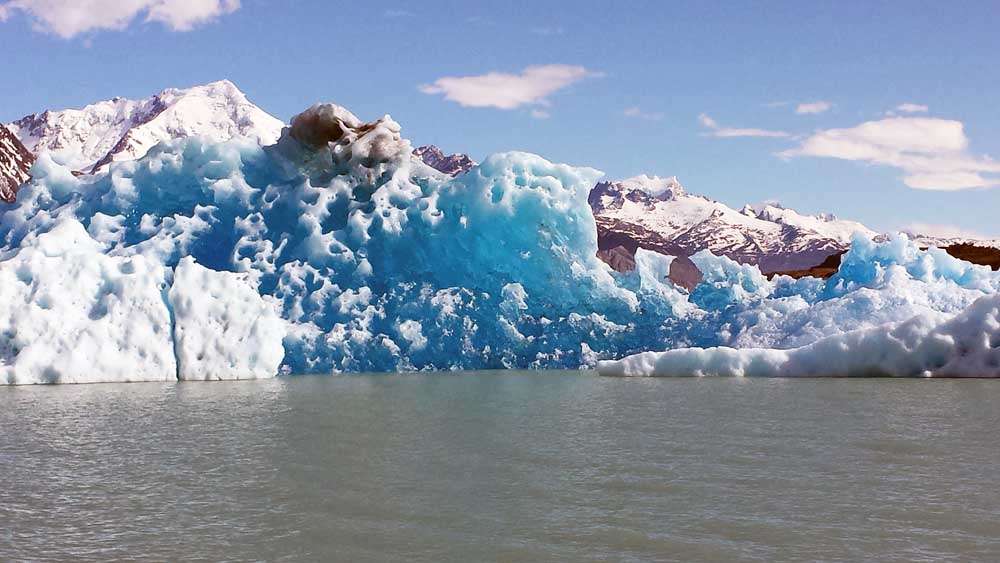
Another bus trip awaited us to Punta Bandera and a three-hour cruise through the north arm of Lago Argentino to reach the Upsala Glacier. Munching croissants and drinking steaming hot coffee, we were again sailing amongst massive icebergs and past the stunning snow-covered peaks. I was pretty much beside myself with joy and astonishment at the various formations of the icebergs gliding by, and allowed my imagination free reign. Having navigated the Upsala Canal and marveled at the Upsala Glacier, we explored the Spegazzini Canal, where we observed the Spegazzini Glacier, the highest in the National Park. Wow – what a memorable experience. My first snow and my first glaciers!!
Tuesday, 3 November 2015
On Monday our outing took us by bus 51km west of El Calafate, to the Parque Nacional Los Glaciares, supposedly one of the most spectacular parks in Argentina. This park is located in the area known as Austral Andes, in the south west of the province of Santa Cruz on the border with Chile. It was declared a “World Heritage” site in 1981. What an amazing experience again. And then we came to where the most famous glacier can be seen: Perito Merino.
All we could say was wow, wow, wow! A massive glacier right in front of our eyes. Of course we took a boat which takes you to almost within touching distance of this massive mountain of ice. Everybody scrambled on board to get a good view of the glacier, cameras clicked and selfies were taken. I was loathe to leave the boat but more was awaiting us. The road ends at the pasareelas, a series of walkways and terraces down a steep cliff, which faces the glacier head on.  Visitors line up along the walkways waiting for a chunk of glacier to calve off into the water with a resounding and thunderous crack. But it was bitterly cold and very windy, so we retreated into the restaurant for a sandwich and hot chocolate and were quite grateful when the bus arrived to take us home to our heated hotel room and an early night’s sleep.
Visitors line up along the walkways waiting for a chunk of glacier to calve off into the water with a resounding and thunderous crack. But it was bitterly cold and very windy, so we retreated into the restaurant for a sandwich and hot chocolate and were quite grateful when the bus arrived to take us home to our heated hotel room and an early night’s sleep.
Wednesday, 4 November 2015
At last a chance for a longer sleep-in and late breakfast. At 13h00 the taxi driver arrived, and we were back to the same ritual – waiting at the airport, leaving for Buenos Aires, waiting at the airport in Buenos Aires for our flight to Salta and eventually at 10h30 arriving there, to be picked up by a very talkative taxi driver, who spoke English well and knew everything about Rugby and kept Kai entertained for the long drive to our new destination, the Kkhala Boutique Hotel, a charming boutique hotel in the residential area of Tres Cerritos, combining tradition with unique antiques and regional craftsmanship. I was in awe of this place.
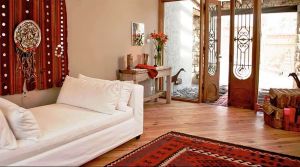 Apparently the owner is a designer and it could be seen in every little item in her hotel. This was right down my alley, there was so much to see and admire – so much attention to detail, just beautiful. But by now it was after midnight, and we were exhausted, so off to bed in one of those over-sized beds that we had the privilege of sleeping in on all our trips.
Apparently the owner is a designer and it could be seen in every little item in her hotel. This was right down my alley, there was so much to see and admire – so much attention to detail, just beautiful. But by now it was after midnight, and we were exhausted, so off to bed in one of those over-sized beds that we had the privilege of sleeping in on all our trips.
A little snippet…We had just left the plane in Buenos Aires when I realised that I had left my Argentina book and my reading glasses on the plane. Oh dear …again. As Kai likes to say” Ich sehe gelassen aus, aber ich sage Nichts”. We rushed to the ‘Lost Items’ counter, where a very helpful gentleman immediately phoned the plane to hear from the cleaning staff whether those items had been located. As it turned out, they only found the book, because it was after all written in English and nobody would have much use for it; however my reading glasses will now be proudly worn by some Argentinian in Buenos Aires. So we ended up spending the time at the airport buying some new reading glasses. By now Kai had lost his too. Our luck had run out in Buenos Aires. This was, however, the last time that we left anything behind!!!
Thursday, 5 November 2015
Wednesday, and we decided to stay in the city. “Salta la Linda” or “Salta the Beautiful”; this is the best description of the city and province that shares the name. Salta is located in the north west of Argentina and borders three countries, Chile, Bolivia and Paraguay. Due to its location, forming a ring between the Andes Mountains to the west and the Argentine-Paraguayan Chaco to the east, Salta has a huge variety of climates and geography. For this reason, landscapes and tourist circuits are incomparable; from the vast and desert like puna to the splendour of the tropical jungle. Besides landscapes, Salta also has the historical and cultural heritage that invites deeper understanding. Travellers will have the opportunity to get in touch with ancient customs that remain alive in the community.
The city of Salta is famous for its museums and its bustling cafe culture. We were intrigued by the eye-catching contrast of its old colonial buildings and its modern architecture. Salta’s main square, Plaza 9 de Julio was interesting, with its imposing Cathedral, Cabildo and other colonial buildings. What fascinated us most though was the Museo de Antropologia, where the three mummified remains of the so-called Ninos de Llullaillaco or Children of Llullaillaco are displayed. The bodies of these children were discovered in 1999, near the summit of the Llullaillaco volcano in the Andean cordillera. They are perfectly preserved by the extreme cold, and anthropologists have concluded that the children were sacrificed in a religious ritual 500 years ago when the Inca Empire ruled northwest Argentina. Only one mummy is on display at any one time. It felt fascinating and disturbing at the same time to see the six-year old boy completely preserved – as if he was just sleeping.
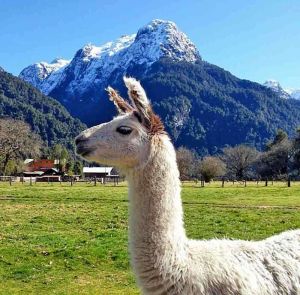
And then it was time for shopping – at last! Kai is no shopper, so I had to cajole him a little, and off we went to the big market, which is famous for its varied handicrafts. We’d been told us that this is the most traditional region of Argentina, and the area where the size and influence of the indigenous population are still significant. I found a beautiful Alpaca shawl and little leather handbag, for my daughter Hannah, plus two Alpaca bowls. It is interesting to note that Alpaca not only refers to the animals, whose wool is famous the world over, but also to the locally crafted silver, which you find in all the craft shops. So I was happy and Kai reluctantly too; I guess for having made me happy!!
In the afternoon we took a tourist bus, which made its way up to Cerro San Bernardo, from where we enjoyed a superb view of the city. We took the cable car down the mountain which was great fun. And in the evening we had Lomo on the main square, real Lomo which melted on our tongues and was delicious, of course together with some good wine, and then off to bed – tired, after a long, adventurous day and looking forward to another expedition the next morning in this spectacular country.
Friday, 6 November 2015
From Salta, a winding but wonderful mountain road took us via San Salvador de Jujuy through a wide and highly distinctive quebrada (gorge), dominated by the Rio Grande. The Quebrade de Humahuaca valley has been used for 10,000 years as an important passage for transporting both people and ideas between the Andean highlands and the plains of Jujuy below. In 2003 it was made a Unesco World Heritage site. And what a trip this turned out to be. Argentina really has so many different sides to it. We were slowly making our way into the desert, past scraggly bushes, cacti, multicoloured desert hillsides, deep canyons and wide valleys.
Some three hours later, we arrived at Pumamarca, or ‘Desert Region’, a tiny village, mostly visited for a landmark that has been here for many millions of years; the Cerro de los Siete Colors (Hill of the Seven Colours).
Those celebrated hues – yellow, orange, red, grey, green and black – were created by marine sediments that accumulated in the rock strata over eons, and are an amazing sight. And the second landmark – for me – was of course the shopping! Purmamarca is also famous for its handicraft, mainly brightly coloured bags, carpets, alpaca, various garish souvenirs etc. I found a two more handbags here, cheap but beautiful.
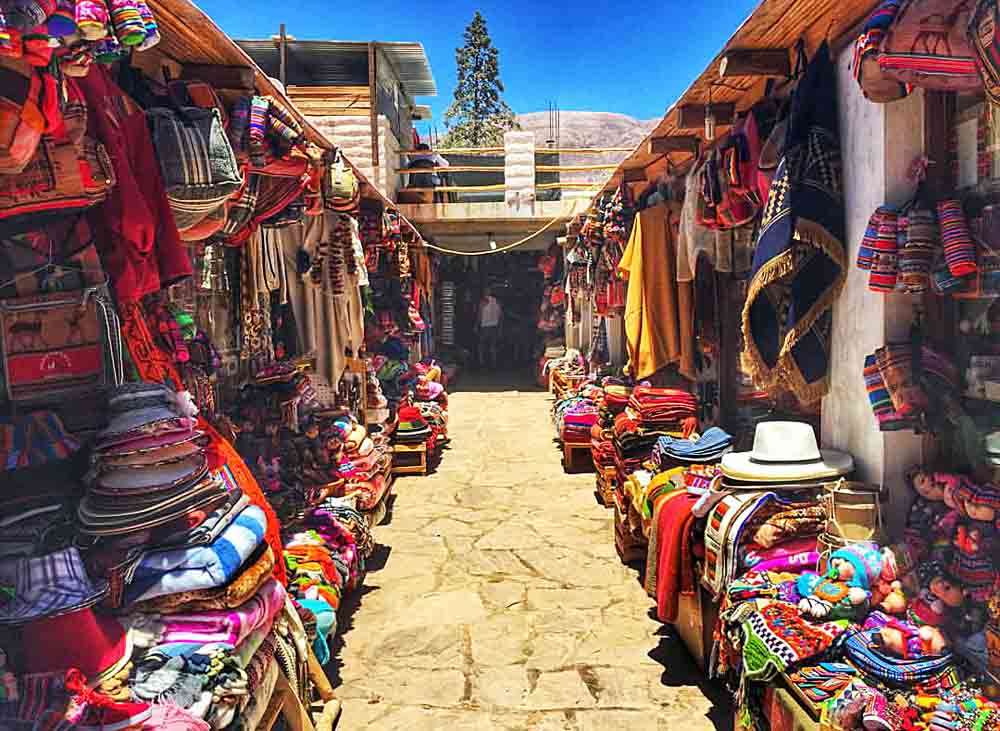
And then, at last, lunch in Tilcara with Empanadas, Locro and Humitas, accompanied by an Argentinean band playing traditional music, which reminded me a lot of the Bolivian music I had heard on the Austrian subways many moons back. I love this music. By the way, communication is difficult in Argentina, especially in the country, where nobody speaks English. Fortunately some of the tourist guides could help us, but mostly it is Spanish and Spanish only. It got tricky sometimes though, especially with the menus in restaurants and directions for the taxi drivers, and led to some consternation and funny, amusing misunderstandings. But we made it back home to SA, so I guess we managed quite well.
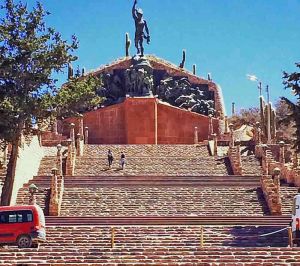
Further up the valley we reached the town of Humahuaca which gives its name to the whole valley, almost 3000metres above sea level. Here we found stone-paved and extremely narrow streets, vendors of herbs and produce, ceramics, again the colourful bags, jewellery and much more. A fascinating little place, however totally overrun by tourists. And this although the real tourist season had apparently just begun. Humahuaca is known for its church and even more so an imposing monument made from 70tons of bronze commemorating the Argentine War of Independence.
For me our trip ended on a real high note when we arrived at the Pucará de Tilcara, which is an archaeological site located in the Quebrada de Humahuaca. The settlement was built on a small hill overlooking the Río Grande, with steep sides and a gently sloping summit. It is thought to have been first occupied in the tenth century A.D. During the fifteenth century, the expansion of the powerful Inca Empire into this region resulted in significant cross-cultural exchange. The Spanish arrived in the valley in 1536, but did not gain control of the area, which included the route to the important silver-mining town of Potosí to the north, until 1595. The settlement was later abandoned and looted for building materials. Archaeological excavations began at the site in 1908. And by the 1950’s many structures were reconstructed to prepare the site for visitors, once common practice around the world that has given way to different approaches to site interpretation today that rely far less on recreating missing elements. I for my part enjoyed it though, that we could wander through these reconstructed houses, places of worship, cemetery, meeting places etc. It felt like being part of ancient cultures and civilizations. Although we were nearly blown off the mountain, the view from there was breathtaking. This is an experience that I will hold dear for the rest of my life.
Not far from the Pucara we were treated to another famous landmark, the La Paleta del Pintor (Painters’ Palette) framing the town of Maimara. With the setting sun settling on this spectacle, it did remind one of a painter’s palette, different colours mingling with each other to create an Argentinian masterpiece. There would be so much more to marvel about, but then I would have to write a book. Argentina is plain majestic in all its different facets!!!
Saturday, 7 November 2015
And then we had to say goodbye to our charming Kkhala Hotel and its friendly staff. This time we were picked up by a lovely lady taxi driver who told us about her family and shared with us her excitement about the new love in her life, a man whom she was going to introduce to her family on the coming weekend. She hugged us generously when we greeted her. The Argentinians are generally warm and welcoming people, they talk easily, especially when they can speak English, and they like to hug. I guess they also cry easily – they are emotional people, and I enjoyed that.
So here we were sitting again at an airport, waiting for our flight back to Buenos Aires, and in the early evening from Buenos Aires to Bariloche where Switzerland awaited, or so it looked like. Founded in 1902, Bariloche (real name: San Carlos de Bariloche) has a very strong Central European influence; most of the first settlers were of Swiss, German or northern Italian origin. These people gave the city its Alpine atmosphere, with Swiss-style chalets, fondue restaurants and chocolates. Bariloche is the real centre of the Northern Lake District of Patagonia and a year-round destination for hikers, nature lovers and of course skiers.
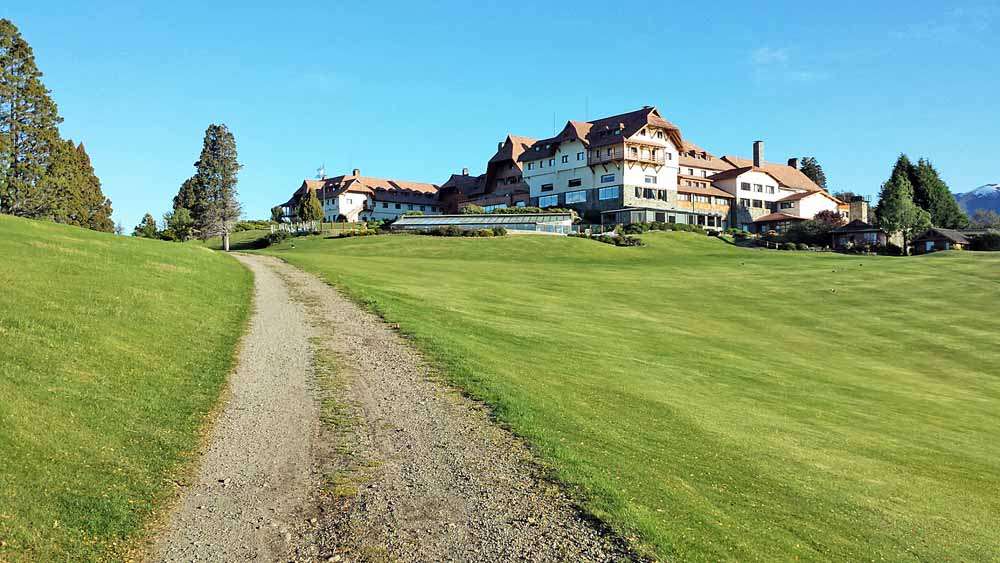
What a surprise awaited us. We’d been pre-booked into no less a hotel than the famous Hotel Llao Llao at the base of the Peninsula Llao Llao. This hotel is one of South America’s best-known and most unique hotels, located between Lake Moreno and Lake Nahuel Huapi, at the feet of snow-capped peaks, offering postcard views in every direction. The hotel was built in 1940, in the style of one of Canada’s grand mountain lodge hotels, with exposed cypress timbers, massive stone fireplaces, and Norman tile roofs. It’s hard to imagine a more dramatic setting, equally alluring in summer or winter, with easy access to golfing, water sports, and some of Argentina’s best skiing—with the added benefit of off-season novelty, for travellers from the Northern hemisphere. I was impressed but also a little intimidated, the hotel reminded me of the likes of Mount Nelson in Cape Town, but I soon felt at home once we were in our comfortable beds and even more so the next morning with the most scrumptious of breakfasts in a superb setting with picture book views.
Sunday, 8 November 2015
Saturday turned into a leisurely outing. We took the local bus for the 25km drive back to Bariloche. Quite an experience, together with the locals in a municipal bus, but which we enjoyed since it connected us to the local Argentineans. So far we had only taken taxis, except in Buenos Aires. We were looking for a bank to withdraw money, which turned into an adventure of its own, since most ATM’s didn’t have any money left. This can apparently happen in Argentina, especially on a Saturday. Eventually we did find an ATM with money, but we had had to walk a lot in the process and were tired.
- Bariloche
- town centre
- and Spaetzle
And what did I see? A restaurant offering Goulash and Spaetzle. The last time I had had Spaetzle was with my mother. I couldn’t believe my eyes. Kai didn’t know about Spaetzle, but he was quickly convinced by me that we had to have Spaetzle. And they were good, nearly as good my mother’s, which lifted my spirits. I don’t think Kai was too impressed, especially not at the price. Argentina is horrendously expensive! Feeling better again though, we went to explore the centre of town. Bariloche is very pretty with stunning buildings, eye-catching shops, and beautiful flower beds and everywhere the distinctive Arrayanes, rare trees related to myrtles and supposedly only found in this area. I wished I could have taken one of them home. We saw many more eventually in Chile, but I still couldn’t take one home! We admired the Museo de la Patagonia in the Civic Centre. This building and the Hotel Llao Llao were designed by architect Alejandro Bustillo in his own interpretation of traditional Alpine style, and they give Bariloche a distinctive architectural personality.
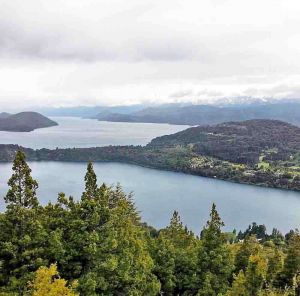
Bariloche spreads along the foot of Cerro Otto. We ended the day off by taking a cable-car ride to the top, from where there are splendid views of the town, the lake and the surrounding park, as well as a revolving cafe, where we had steaming hot chocolate. It had become cold again. In Salta the weather had been temperate with rain, but here in Bariloche it was really cold!
Monday, 9 November 2015
I felt sad to leave Bariloche. There would have been so much more to explore. However, new adventures were waiting.
We were lucky. The weather was going to be sunny and pleasant for our lake crossing from Bariloche to La Peulla in Chile.
More on our next post as we travel on our final leg for a glance into Chile
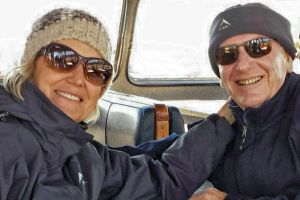 Karen and her husband Kai became friends as we met and travelled together in Botswana. Their lively approach to life and extensive globe trotting makes them ideal contributors to The Luxury Couple. We hope you agree!
Karen and her husband Kai became friends as we met and travelled together in Botswana. Their lively approach to life and extensive globe trotting makes them ideal contributors to The Luxury Couple. We hope you agree!
If you missed the first part of their blog about Buenos Aires then see it here


 Let us plan your own inspiring journey to Argentina and throughout Central & S. America
Let us plan your own inspiring journey to Argentina and throughout Central & S. America
Why not download the TLC World guide brochure or give us a call today on 01202 030443, or simply click ‘enquire’ to submit your own personal itinerary request
SPECIAL NOTE: Zika Virus
Warnings about Zika Virus in South America are still current. To check if you’re vulnerable to it and its effects, please read this information from:




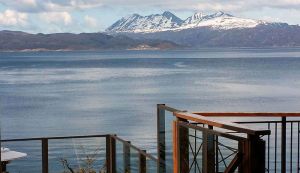





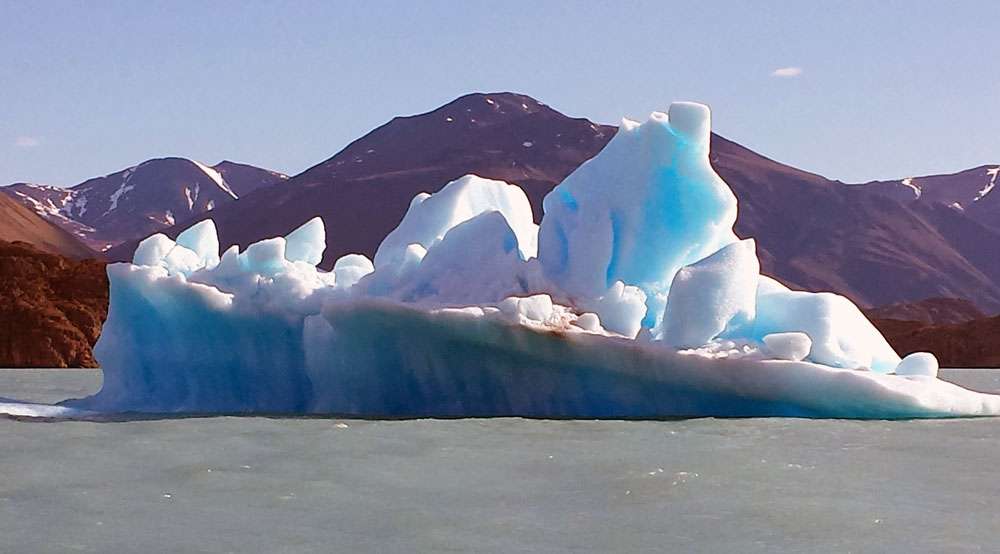
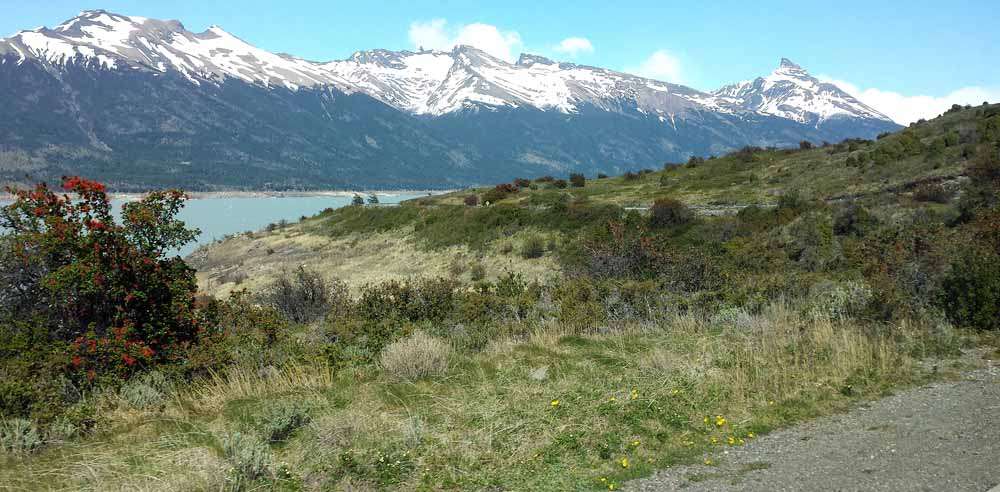
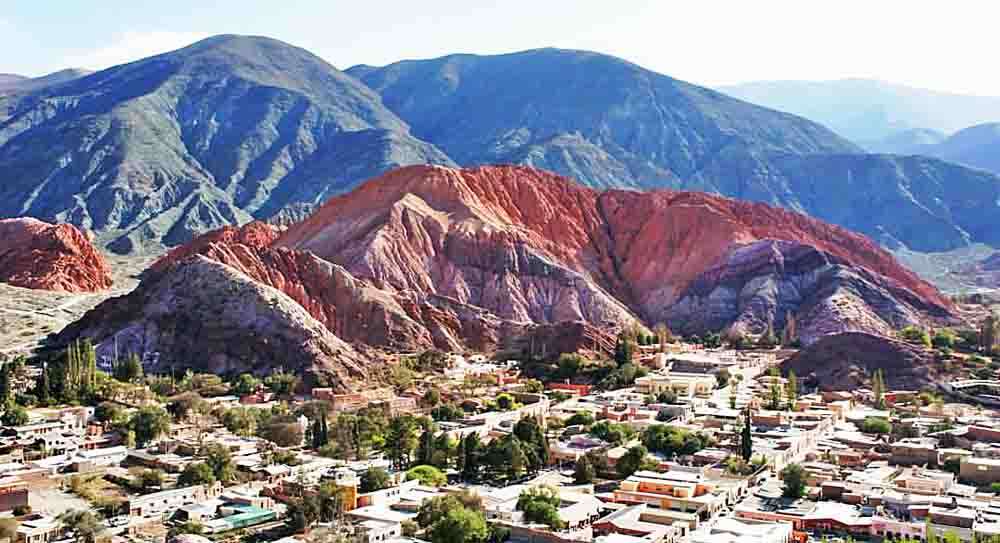
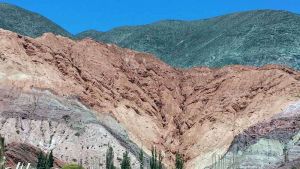



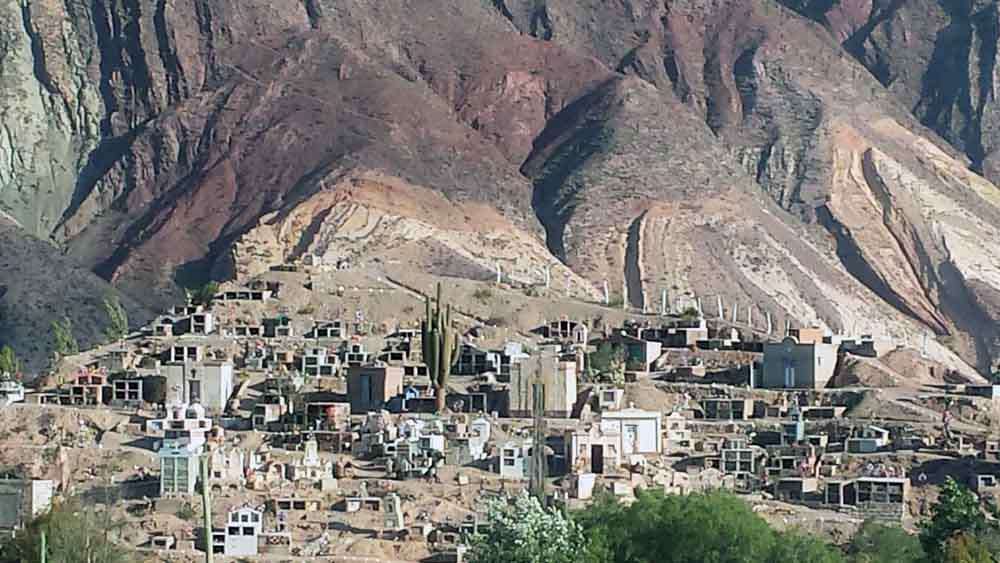
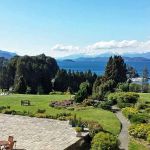





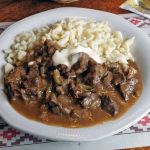






March 2, 2016
He leido vuestro post con mucha atecion y me ha parecido ameno ademas de facil de leer. No dejeis de cuidar este blog es buena.
Saludos
proyecto ingenieria alicante http://www.arquestil.es/proyectos
September 19, 2018
Que pasada me encantaría visitarlo!